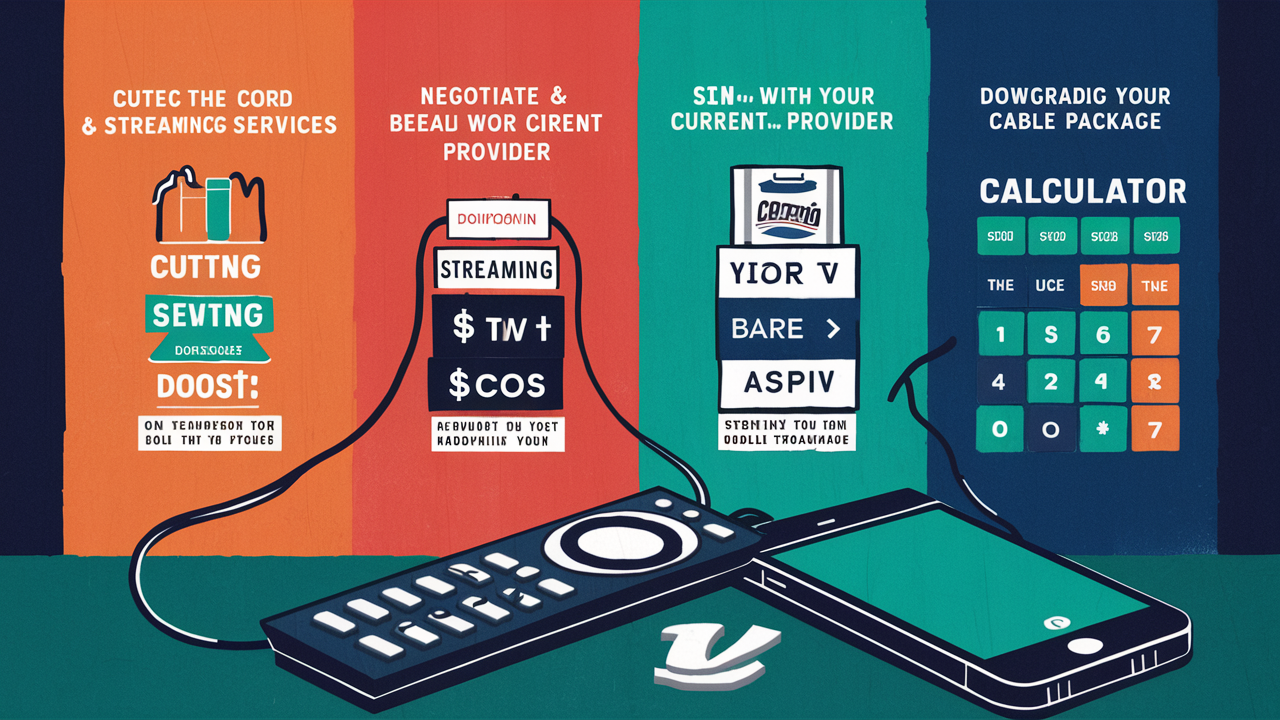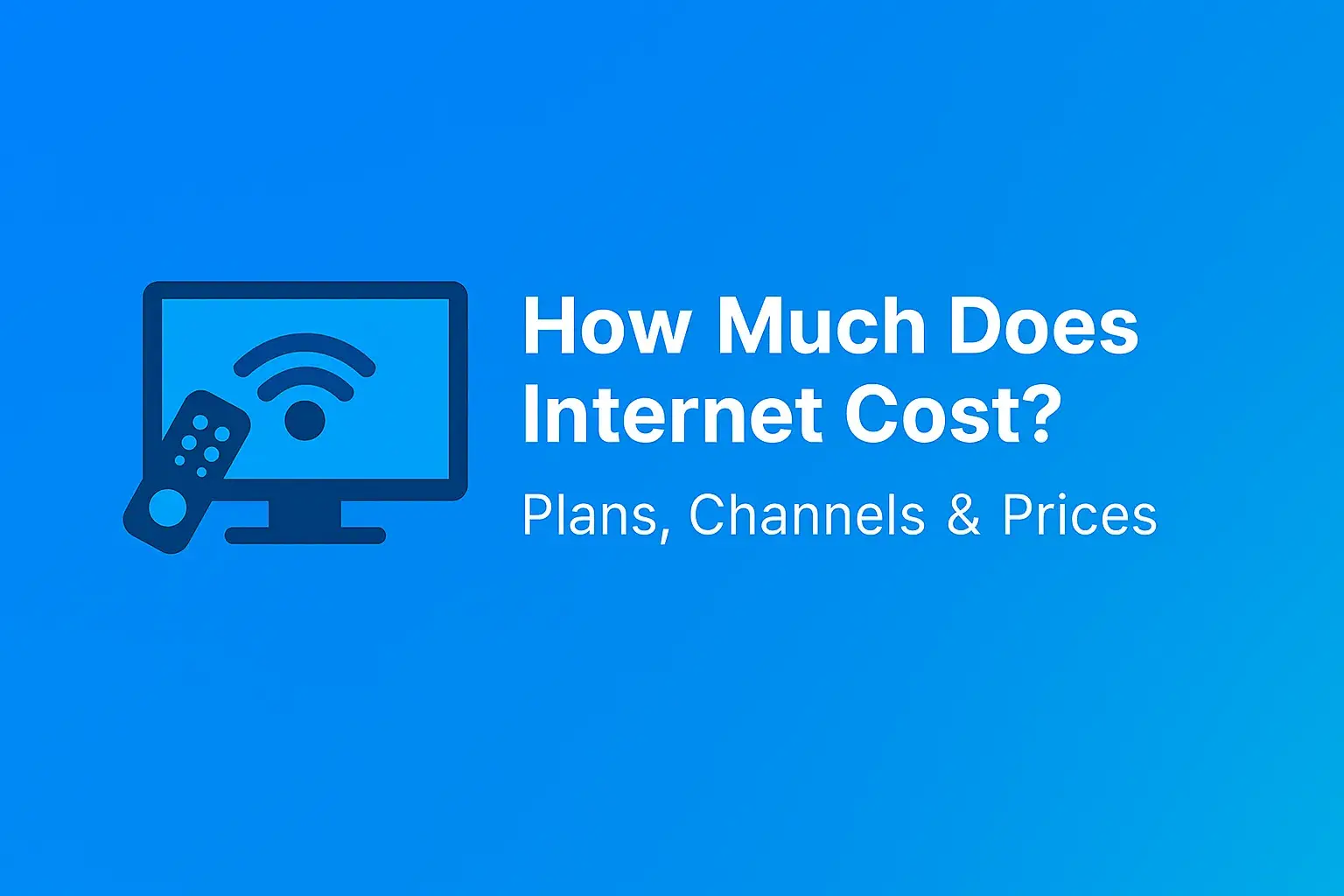How can I reduce my TV cost per month?

Are you tired of your monthly television bill eating into your budget? This comprehensive guide reveals actionable strategies to significantly reduce your TV costs, from optimizing your current plan to exploring budget-friendly alternatives. Discover how to save money without sacrificing your favorite entertainment.
Understanding Your Current TV Bill
The first step to reducing your TV costs is a deep dive into what you're actually paying for. Many subscribers overlook the details on their monthly statements, leading to unnecessary expenses. In 2025, the average household spends approximately $115 per month on pay-TV services, a figure that can be significantly lowered with a strategic approach. Understanding the breakdown of your bill is crucial for identifying areas where you can cut back.
Deconstructing Your Statement
Your TV bill likely includes several components:
- Base Package Fees: This is the core cost for your chosen channel lineup.
- Premium Channels: Subscriptions to channels like HBO, Showtime, or sports packages.
- On-Demand and PPV Charges: Costs incurred from renting movies or ordering pay-per-view events.
- Equipment Rental Fees: Charges for set-top boxes, DVRs, and modems.
- Taxes and Fees: Various local, state, and federal surcharges.
- Promotional Discounts: Temporary price reductions that expire, leading to price hikes.
By carefully examining each line item, you can pinpoint exactly where your money is going. For instance, are you paying for premium channels you rarely watch? Are you still renting equipment you no longer need? Identifying these details is the foundation of effective cost reduction.
Identifying Hidden Costs and Price Hikes
Providers often introduce price increases after promotional periods end. It's common for these hikes to go unnoticed if you're not actively tracking your bill. Look for phrases like "price adjustment" or "regular rate" that indicate a shift from a promotional price. Additionally, some providers might bundle services in ways that aren't immediately obvious, making it difficult to discern the true cost of your TV service versus other bundled offerings.
Assessing Your Viewing Habits
Before you can make informed decisions about cutting costs, you need to understand your actual TV consumption. In 2025, with the proliferation of streaming, many households are subscribed to multiple services. Ask yourself:
- Which channels do I watch most frequently?
- Are there specific premium channels I absolutely cannot live without?
- How often do I use on-demand or pay-per-view services?
- Do I need the highest-tier DVR service, or would a basic one suffice?
Honest self-assessment of your viewing habits will prevent you from paying for content or features you don't utilize. This data is invaluable when you start negotiating or exploring alternatives.
Negotiating with Your Current TV Provider
Many consumers assume their cable or satellite bill is non-negotiable. This is rarely the case. Providers are keen to retain existing customers, especially in a competitive market. A well-prepared negotiation can lead to significant savings. The key is to be informed, polite, and firm.
Preparation is Key
Before you pick up the phone, gather your information:
- Your Account Details: Have your account number and personal information ready.
- Your Bill: Keep your latest bill handy to reference specific charges.
- Competitor Offers: Research what rival providers in your area are offering. Note down their package prices and promotions. This gives you leverage.
- Your Viewing Habits: As discussed, know what you actually watch and what you can live without.
- Your Goal: Decide what you want to achieve – a lower monthly rate, removal of unused channels, or a better equipment deal.
The Negotiation Call: Step-by-Step
- Call Customer Retention: When you call your provider, specifically ask to speak to the "cancellation department" or "customer retention." These agents are empowered to offer deals to keep you from leaving.
- State Your Intent Clearly: Be polite but direct. "Hello, I'm calling because I'm reviewing my monthly expenses, and my current TV bill of [Your Current Bill Amount] is higher than I can afford. I'm considering switching to a competitor or cutting the service altogether."
- Highlight Competitor Offers: "I've noticed that [Competitor Name] is offering a similar package for [Competitor Price] per month, or that [Another Competitor] has a promotion for new customers at [Another Competitor Price]."
- Request Specific Reductions: Instead of a vague "lower my bill," ask for specific things. "Could you offer me a discount on my current package for the next 12 months?" or "I'm paying for [Premium Channel] but rarely watch it. Can that be removed to lower my bill?"
- Be Willing to Walk Away (or Threaten To): If the initial offers aren't satisfactory, politely state that you'll have to explore other options. Sometimes, the threat of losing a customer is enough for them to sweeten the deal.
- Confirm Everything in Writing: Once you agree on a new rate or package, ensure you get a confirmation email or letter detailing the changes, the new price, and the duration of the promotion.
Leveraging Promotions and Discounts
Providers often have new customer promotions that are significantly better than what they offer existing customers. By expressing interest in switching, you can often gain access to these same deals. Ask about:
- Loyalty Discounts: Special rates for long-term customers.
- Bundled Discounts: If you also have internet or phone with them, inquire about combined package savings.
- Seasonal or Special Offers: Sometimes providers have limited-time deals.
Remember, the goal is to secure a sustainable lower price, not just a temporary fix. Aim for at least a 10-20% reduction in your monthly bill.
The Art of Bundling and Unbundling Services
For years, bundling services like TV, internet, and phone was the primary way providers offered discounts. However, in 2025, the landscape is shifting, and understanding when to bundle and when to unbundle is crucial for cost savings.
When Bundling Makes Sense
Bundling can be beneficial if:
- You Use All Services Extensively: If you need high-speed internet, a reliable home phone line, and a comprehensive TV package, a bundle can offer a consolidated discount.
- The Bundle Price is Significantly Lower: Compare the bundled price against the cost of each service purchased separately from the same provider or from different providers.
- You Value Simplicity: Having one bill for multiple services can simplify your financial management.
Example: A provider might offer a bundle of internet, TV, and phone for $150/month. If buying these separately would cost $70 for internet, $60 for TV, and $40 for phone, totaling $170, the bundle saves you $20. However, this is not always the case.
When Unbundling is the Smarter Choice
Unbundling is often more advantageous if:
- You Don't Need All Services: Many households no longer require a landline phone.
- You Can Get Better Deals Separately: You might find a superior internet deal from one provider and a more affordable TV solution from another.
- Your Current Bundle Has Expired Promotions: Often, the bundled discount disappears after the introductory period, making individual services cheaper.
Example: Your bundled TV and internet package costs $130 after a promotion ends. You find that standalone internet from a competitor is $60, and a streaming TV service (explained later) costs $40. This unbundled approach saves you $30 per month.
Evaluating Your Specific Needs
The decision to bundle or unbundle depends entirely on your individual usage patterns and the offers available in your area. In 2025, the rise of high-speed internet and diverse streaming options means you have more flexibility than ever before. Don't assume a bundle is automatically the cheapest. Always do the math:
Cost of Bundle vs. Sum of Individual Service Costs (from same or different providers).
Exploring Alternative TV Options
The traditional pay-TV model is no longer the only game in town. A plethora of alternative options can offer more flexibility and significant cost savings. These alternatives cater to a wide range of viewing preferences and budgets.
Over-the-Air (OTA) Antenna
For many, this is the most overlooked and cost-effective solution. An OTA antenna can provide free access to local broadcast channels (ABC, CBS, NBC, FOX, PBS, etc.).
- Cost: One-time purchase of an antenna (ranging from $20 to $100+ depending on type and range).
- Channels: Varies by location, but typically includes major networks and some sub-channels.
- Pros: Free after initial purchase, no monthly fees, excellent HD quality.
- Cons: Limited channel selection (no cable-specific channels), signal strength can be affected by location and weather.
In 2025, with improved antenna technology, reception is better than ever. A simple indoor antenna can be sufficient for many urban and suburban dwellers, while outdoor antennas offer extended range for rural areas.
Streaming TV Services (vMVPDs)
These services, also known as "virtual Multichannel Video Programming Distributors," offer live TV channels over the internet, mimicking traditional cable packages but without the long-term contracts or equipment rental fees. Examples include YouTube TV, Hulu + Live TV, Sling TV, and FuboTV.
- Cost: Varies by service, typically $30-$80 per month.
- Channels: Offer a wide range of channels, often comparable to basic cable packages.
- Pros: No contracts, flexible plans, often include DVR functionality, accessible on various devices.
- Cons: Requires reliable internet, channel lineups can change, some premium channels may cost extra.
Comparison of Popular Streaming TV Services (2025 Estimates):
| Service | Starting Price (Approx.) | Key Features | Target Audience |
|---|---|---|---|
| Sling TV (Orange/Blue) | $40/month | Customizable, affordable base packages, add-ons available. | Budget-conscious viewers, those wanting specific channel groups. |
| Hulu + Live TV | $77/month | Includes Hulu's on-demand library, live TV, and Disney+. | Those who want a comprehensive entertainment package. |
| YouTube TV | $73/month | Extensive channel lineup, unlimited cloud DVR, family sharing. | Families, sports fans, those wanting a full cable replacement. |
| FuboTV | $80/month | Strong focus on sports, includes many sports channels. | Serious sports enthusiasts. |
Note: Prices are approximate and can change. Always check the provider's website for the latest information.
On-Demand Streaming Services
While not live TV, these services offer vast libraries of movies, TV shows, and original content that can replace much of what you watch on traditional TV. Examples include Netflix, Max, Disney+, Amazon Prime Video, Apple TV+.
- Cost: Typically $7-$20 per month per service.
- Content: Exclusive originals, extensive back catalogs of popular shows and movies.
- Pros: On-demand viewing, affordable when selected strategically, no contracts.
- Cons: No live news or sports (unless bundled with a live TV streaming service), can become expensive if subscribing to many.
The key here is to subscribe only to services that offer content you genuinely want to watch and to rotate subscriptions based on new releases or seasons.
Local Library and Public Domain Content
Don't forget the free resources available! Many public libraries offer DVDs and Blu-rays that you can borrow for free. Additionally, websites like Internet Archive host a wealth of public domain films and classic television shows that can be streamed legally and without cost.
Optimizing Your Streaming Service Subscriptions
Streaming services offer incredible value, but the subscription creep can quickly inflate your monthly entertainment costs. In 2025, the average US household subscribes to around 4-5 streaming services, costing upwards of $60-$80 per month. Strategic management is essential.
The Rotation Method
This is perhaps the most effective strategy for saving money on streaming. Instead of keeping all your subscriptions active year-round, subscribe to a service for a month or two, watch the content you're interested in, and then cancel it. Rotate through different services based on new releases, popular shows, or specific seasons.
Example:
- Month 1: Subscribe to Netflix for new original series.
- Month 2: Cancel Netflix, subscribe to Max for a specific show or movie.
- Month 3: Cancel Max, subscribe to Disney+ for new Marvel or Star Wars content.
This way, you pay for entertainment access only when you're actively using it, rather than paying for dozens of services simultaneously.
Sharing Accounts (Within Terms of Service)
Many streaming services allow multiple profiles and simultaneous streams on a single account. If you live with family or roommates, sharing an account can significantly reduce individual costs. However, be mindful of each service's terms of service regarding account sharing outside of a household, as some are cracking down on this.
Example: A Netflix Premium plan ($20/month) allows 4 simultaneous streams. If you share this with three other people, the cost per person drops to just $5 per month.
Utilizing Free Trials and Promotions
Most streaming services offer free trials for new subscribers. Use these strategically to watch content without paying. Additionally, keep an eye out for bundled promotions, such as those offered with certain mobile phone plans or internet packages.
Choosing the Right Tier
Many streaming services offer different subscription tiers (e.g., basic, standard, premium) with varying features like video quality (SD, HD, 4K) and the number of simultaneous streams. Opt for the lowest tier that meets your needs. Do you really need 4K streaming for every show, or is HD perfectly acceptable? In 2025, many households still find HD to be sufficient for most viewing.
Consolidating Services
Consider services that bundle multiple offerings. For instance, Hulu + Live TV includes Hulu's extensive on-demand library. Disney+ bundles Disney, Pixar, Marvel, Star Wars, and National Geographic content. These can sometimes be more cost-effective than subscribing to each individually.
Tracking Your Subscriptions
Use apps or spreadsheets to keep track of all your active subscriptions, their costs, and renewal dates. This helps prevent unwanted auto-renewals and provides a clear overview of your total monthly streaming expenditure. Services like subscription management apps can be invaluable.
Reducing Equipment Costs
Equipment rental fees from cable and satellite providers can add a surprising amount to your monthly bill. In 2025, these fees can range from $10 to $25 per month or more for advanced DVRs and multiple boxes.
Purchasing Your Own Equipment
For cable and satellite TV, you often have the option to purchase your own compatible set-top boxes and DVRs instead of renting them. While the upfront cost can be higher (typically $100-$300), it can lead to significant savings over time. Check with your provider to ensure compatibility before purchasing.
Example: If your provider charges $15/month for a DVR rental, purchasing one for $200 would pay for itself in just over 13 months ($200 / $15 = 13.33).
Using Streaming Devices
If you've transitioned to streaming services, you'll need a device to access them on your TV. Instead of relying on smart TV apps that can sometimes be clunky or slow, consider dedicated streaming devices:
- Roku Devices: Offer a wide range of streaming apps and are generally affordable.
- Amazon Fire TV Sticks: Integrate well with Amazon's ecosystem.
- Apple TV: A premium option with excellent performance and integration for Apple users.
- Google Chromecast: Allows casting content from mobile devices to your TV.
These devices typically cost between $30 and $150 and offer a superior streaming experience compared to built-in smart TV apps, eliminating the need for costly cable boxes.
Eliminating Unused Boxes
If you have multiple cable or satellite boxes in your home that are rarely used, contact your provider to remove them and stop the associated rental fees. This is a simple yet effective way to reduce your monthly bill.
Considering Alternatives to Traditional Cable Boxes
If you're using a streaming TV service (vMVPD), you might still be offered a proprietary streaming box by the provider. While convenient, these often come with rental fees or are more expensive than off-the-shelf streaming devices. Research whether you can use your own Roku, Fire TV, or Apple TV with your chosen streaming TV service to avoid these extra costs.
Managing Internet and TV Together
For many, internet and TV are intrinsically linked. Optimizing one can often lead to savings in the other, or at least ensure you're not overpaying for both.
Bundling Internet and TV Revisited
As discussed earlier, a bundle can be cost-effective if you use both services extensively. However, it's crucial to negotiate the *entire* bundle price. Don't just focus on the TV portion. Inquire about discounts for bundling internet with a streaming TV service, or even with a mobile phone plan.
Assessing Your Internet Speed Needs
Streaming TV, especially in HD or 4K, requires a decent internet speed. However, many households pay for internet speeds far exceeding their actual needs. For basic streaming and general web browsing, 50-100 Mbps is often sufficient. For multiple simultaneous streams or heavy online gaming, you might need 200-500 Mbps or more.
In 2025, internet providers offer a wide range of speeds. Test your current speed using online tools and compare it to your actual usage. If you're paying for 1 Gbps but only using 100 Mbps, you're overpaying significantly.
Negotiating Internet-Only Deals
If you've cut the cord on traditional TV and are only using streaming services, you can focus solely on getting the best internet deal. This often involves negotiating with your provider or switching to a different one that offers more competitive standalone internet packages.
Considering Fixed Wireless or Satellite Internet (for rural areas)
If you live in a rural area where high-speed cable or fiber is unavailable, you might be limited to fixed wireless or satellite internet. These options can be more expensive and slower, but compare providers carefully. Sometimes, bundling these with a specific streaming TV package can offer a better overall value than traditional satellite TV.
The Impact of Data Caps
Be aware of data caps on your internet plan. Streaming video consumes a significant amount of data. If your provider has a strict data cap, you might need to upgrade your plan or face overage charges, which can negate any savings made on TV costs. Most unlimited plans are preferable for heavy streamers.
Long-Term Strategies for Sustained Savings
Reducing your TV cost per month isn't a one-time fix; it requires ongoing attention and adaptation. Implementing long-term strategies ensures your savings are sustainable.
Regularly Review Your Bills and Subscriptions
Make it a habit to review your TV, internet, and streaming bills at least every six months. Look for price increases, expiring promotions, or services you no longer use. This proactive approach prevents unexpected cost hikes.
Stay Informed About Market Changes
The media and telecommunications landscape is constantly evolving. New streaming services emerge, existing ones change their pricing or offerings, and providers introduce new technologies. Staying informed allows you to adapt your strategy and capitalize on new savings opportunities.
Embrace a "Less is More" Philosophy
Resist the urge to subscribe to every new service or premium channel that becomes available. Ask yourself if the added cost truly justifies the value you receive. In 2025, the sheer volume of content can be overwhelming, and often, a curated selection of essential services is all you need.
Consider DIY Entertainment Solutions
Beyond streaming, think about other forms of entertainment that are less costly. Reading books from the library, enjoying podcasts, playing board games, or engaging in outdoor activities are all excellent, budget-friendly ways to spend your leisure time.
Set a Realistic Entertainment Budget
Determine how much you can comfortably afford to spend on entertainment each month, including TV, streaming, movies, and other related costs. Stick to this budget by making conscious choices about your subscriptions and viewing habits.
Educate Yourself on Cord-Cutting Benefits
Understand the full scope of "cord-cutting" – the practice of canceling traditional pay-TV services in favor of cheaper alternatives. This includes not just saving money on TV but potentially also on internet if you can downgrade your speed or switch providers. Resources like online forums and dedicated websites offer a wealth of information and user experiences.
Negotiate Internet Service Annually
Since internet is often a necessary component of modern entertainment, make it a point to negotiate your internet service contract or price at least once a year. Providers are often willing to offer better deals to retain customers, especially if you've done your research on competitor pricing.
By consistently applying these strategies, you can ensure your TV costs remain manageable and contribute positively to your overall financial health, allowing you to enjoy your entertainment without breaking the bank.
Conclusion
Reducing your monthly TV cost is an achievable goal with the right approach. By thoroughly understanding your current bill, actively negotiating with providers, strategically unbundling services, exploring cost-effective alternatives like OTA antennas and streaming, optimizing your streaming subscriptions, and managing equipment costs, you can reclaim a significant portion of your budget. In 2025, the power to control your entertainment expenses lies with you. Implement these actionable steps, stay vigilant about your spending, and enjoy a more affordable and flexible TV experience. Start by reviewing your latest bill and identifying just one area where you can make a change today.





